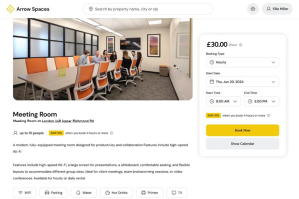State of the Flex Workspace Market 2024 with Will Kinnear: Boom, Nuance and the Road Ahead
The flex workspace market has become a defining feature of the modern work landscape.
This interview with industry expert Will Kinnear, founder of HEWN, delves into the current state of the market in 2024, revealing not just the undeniable boom, but the nuances and potential challenges that lie ahead.

A Market on the Rise: Demand, Diversity and the Hybrid Advantage
Will paints a clear picture: the flex workspace market is thriving. Demand is surging, driven by the increasing popularity of hybrid work models. Businesses are embracing the flexibility and scalability that flex spaces offer, allowing them to adapt their workspace needs to a fluctuating workforce while avoiding the long-term commitments of traditional leases.
“In terms of the flex space market as a whole, it’s going from strength to strength. Product, service, and hospitality is what everybody’s looking towards in terms of being property owners, landlords, tenants… they’re all looking the same way and flex space operators are there to reap the rewards of this.”
This trend benefits not just employers, but also landlords and property owners. Flex space operators act as a bridge between these entities, providing a readily deployable solution that attracts tenants and generates diverse revenue streams.
Beyond Vanilla: Tiered Offerings and the Flight to Quality
However, the market is not stagnant. Will emphasises a crucial shift: the move from a one-size-fits-all approach to a tiered system. The “vanilla” flex space of the past is giving way to a diverse range of offerings.
“The serviced office product was fairly vanilla before WeWork transformed the landscape as we know it. With beer on tap, football tables, a move to a service based product with hospitality created a diversity of offer.”
High-end spaces cater to businesses seeking premium amenities and a hospitality-focused experience. Think concierge services, on-site events and meticulously designed work environments that prioritise well-being and productivity. These spaces function not just as work areas, but as strategic tools for attracting and retaining talent in a competitive job market. The ability to monetise this space has been a significant turning point for the market.
Location Matters: Micro-Markets and the Price Squeeze
While the overall trend is positive, Will acknowledges the influence of location-specific factors. Certain micro-markets might experience an oversaturation of similar flex space options – which can lead to price pressures, even in the face of rising demand. Operators in these areas need to be strategic in their pricing and offer to stand out.
“In some markets there is perhaps a little too much of the same sort of product, which is leading to prices being squeezed, even as demand is going up across the board.”
The key lies in understanding the specific needs of the local market and tailoring their services accordingly.
Economic Headwinds and the Budget-Conscious Client
Beyond micro-market fluctuations, the potential for a broader economic downturn later in 2024 cannot be ignored. Will highlights how such a scenario could put a premium on budget-friendly options. Flex space providers who offer cost-effective solutions without compromising on core functionalities will likely see increased demand.
“Price points are hugely important, especially in a challenging economy. We are seeing a splitting of the market, and those in the middle are likely going to struggle the most.”
This underscores the need for adaptability within the industry. Operators who understand their audience and who they are catering for will be best placed to take advantage of a changing economic landscape.
Blurring Lines: Operator Innovation and the Evolving Landscape
Another intriguing point raised by Will is the blurring of lines between different flex space operators. Historically, there might have been clearer distinctions, with certain providers known for specific types of spaces or services. Today, however, operators are expanding their offerings, venturing into new segments, and competing across the board. This trend can make it more difficult to categorise them neatly, but it also signifies a dynamic and innovative market.
“It used to be quite easy to pinpoint where an operator sat in terms of the tier of product being provided, today that line is not so clearly delineated anymore.”
Operators are constantly seeking ways to differentiate themselves, whether through unique design elements, specialised technology integrations, or fostering a strong sense of community within their spaces.
The Future of Flex: Growth, Adaptability and the Human Touch
Looking towards the horizon, Will offers an optimistic perspective. The flex workspace market is poised for continued growth, fuelled by the ongoing shift towards hybrid work models.
Demand for new and innovative products, services, and hospitality experiences will drive further development. While economic factors might necessitate some adjustments, the overall trajectory suggests a strong and adaptable market that is well-equipped to cater to the evolving needs of businesses and their workforces.
“The human touch will remain a crucial differentiator. While technology will continue to play a significant role in the future of flex spaces, fostering a sense of community and creating spaces that inspire collaboration and connection will be essential for success. Ultimately, the most successful flex space providers will be those that understand exactly who their offering is tailored towards and can stand out in an increasingly crowded marketplace.”
Thinking of making the move to flex? Or maybe to streamline the management of your existing coworking or flex workspace? Discover how Yardi Kube can help you achieve your goals in flex.
Don’t miss out on any updates – follow Yardi Kube on LinkedIn.




